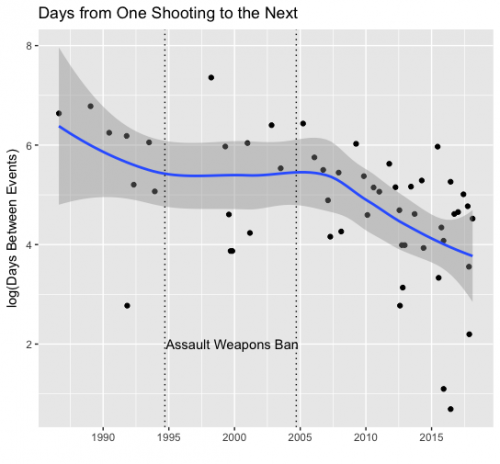The data on mass shootings show that the frequency of these killings has been increasing. Many of the killers have used military-style rifles, including the AR-15. The use of these rifles has prompted some people to call for a renewal of the federal ban on assault weapons, which was passed by Congress on September 13, 1994, and expired on September 13, 2004.
Critics of the proposed ban argue that the definition of an ‘assault rifle’ is vague and arbitrary. There is merit in that claim, although I am not sure how much we should care if the ban saves lives anyway. To the latter point, however, critics claim that the 1994 ban had little effect.
I can’t evaluate whether the ban worked. That would require time, data sets, and expertise that I lack. But I decided to look at my data set of shootings where more than four people were killed and see if there was any evidence about the effect of the ban.*
Below is a graph of the logarithm of the days between successive massacres, as a function of their dates. I have also plotted a loess-smoothed curve to look for trends in the data. The fall in the curve means that the time between events is decreasing, which is another way of saying that the frequency of massacres is increasing. The vertical lines mark the beginning and end of the assault weapon ban.

Taking the logarithm makes the increase in frequency look less dramatic: the untransformed data are much scarier. However, because all you see in the untransformed data is the speedup in the rate of massacres, it’s hard to see anything else. What this graph shows, however, is that the frequency of mass killings was increasing before the ban started and after it ended, but that it paused while the ban was in effect. Christopher Ingraham makes a related argument here in the Washington Post.
There are so many caveats needed here. First, this is a small dataset. Massacres are, thanks be to God, uncommon events (albeit becoming more common). Second, the coincidence of a slowdown with the assault weapons ban proves nothing. These data can’t tell us whether the ban caused the slowdown; it could have been something else in that decade. Finally, the slowdown in the increase in massacres means that lives were saved. That’s good and worth doing, but what we want is for the curve to trend up.
Bottom line: I can’t tell you that the assault weapon ban worked. But it may have had a small effect.
*Thanks to friend-of-the-blog Dr. David States for the prompt to look at this.
